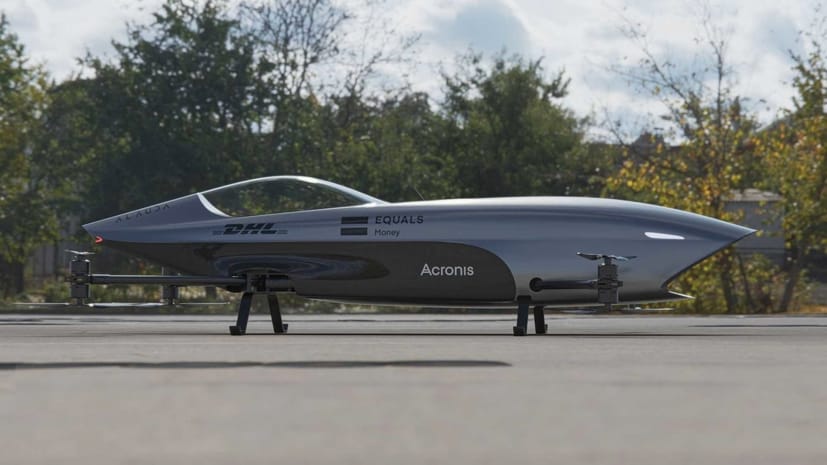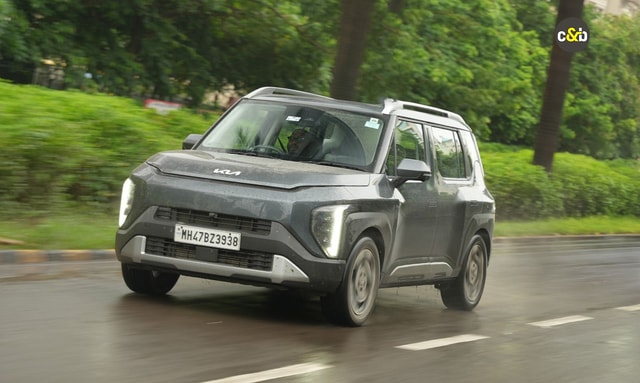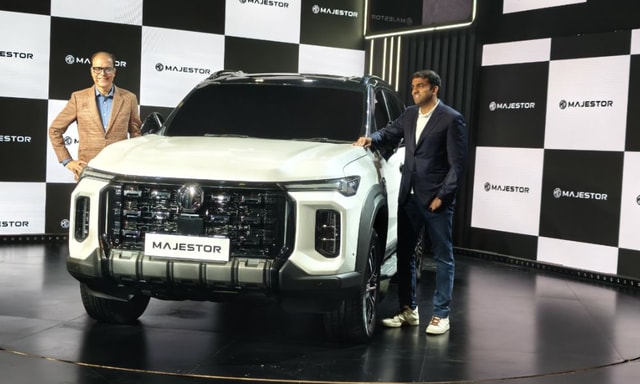World's First Flying Electric Car Takes Off In Australia

- Alauda Airspeeder Mk3 has a lithium battery which lasts for 15 minutes
- There are plans for a F1 style race series which will feature real pilots
- Batteries will be swapped in pitstops that take 20 seconds
The world's first flying electric car took off in Australia ahead of a race series that would involve remotely piloted flying electric cars. This series is planned for later in the year. The flying electric car in question is the Alauda Airspeeder MK3 which is a four metre-long multi-copter. It made its first unmanned flight in the Southern Australian desert with the approval of the Australian Civil Aviation Safety Authority. The Airspeeder MK3 weighs 130 kilograms and has a thrust to weight ratio that exceeds that of a fighter aircraft. The vehicle was bull by Alauda Aeronautics founded by Matthew Pearson. He plans on starting an F1 style series for racing on flying cars. Three races are already scheduled for 2021, though the locations haven't been finalised.
Depending on the conditions, these vehicles will have the ability to fly between 150-250 kmph. The aircraft even has space for a cockpit that could host a human pilot but as of now it is robotically controlled by a "telerobotic avatar". So basically, a robot flies the vehicle.
"We've got a robot in the cockpit, linked up to a pilot on the ground. When the pilot turns their head, the robot turns their head," Pearson told the Guardian.

It is the world's first flying electric car
The broader plan involves having races with human pilots in them. However for that to happen the first three races have to go smoothly which will have the telerobotic avatar manning the vehicles. These flying cars are also equipped with LiDAR and radar systems, tech that's usually found in self-driving cars. They are meant to avoid mid-air collisions, especially during racing.
"Basically, the pilot has complete freedom ... but we can create a virtual force-field between the aircraft in the air, even at really high speeds," Pearson said.
It also gets powered by a lithium-polymer battery with a battery life of about 15 minutes. Each race will last 45 minutes requiring a pitstop for battery swaps which is a 20-second process, something that's not too dissimilar from what happens in F1, where tyres are changed. Many companies are working on flying cars - including start-ups like Kitty Hawk which is backed by Alphabet/Google founder Larry Page and even ride-sharing companies like Uber.
Latest News
 Jaiveer Mehra | Jan 17, 20262026 Tata Punch Facelift Price, Variants ExplainedUpdated Punch is available in 8 trim levels with naturally aspirated petrol, CNG and turbo-petrol engine options.3 mins read
Jaiveer Mehra | Jan 17, 20262026 Tata Punch Facelift Price, Variants ExplainedUpdated Punch is available in 8 trim levels with naturally aspirated petrol, CNG and turbo-petrol engine options.3 mins read car&bike Team | Jan 17, 2026Skoda Kushaq Facelift Teased Ahead of Launch In Coming WeeksMid-lifecycle update to bring with it styling updates as well as new features inside the cabin.1 min read
car&bike Team | Jan 17, 2026Skoda Kushaq Facelift Teased Ahead of Launch In Coming WeeksMid-lifecycle update to bring with it styling updates as well as new features inside the cabin.1 min read car&bike Team | Jan 16, 2026Pierer Mobility AG Rebranded as Bajaj Mobility AG Following KTM TakeoverThis marks a major shift in ownership and strategic direction in the global motorcycle industry.1 min read
car&bike Team | Jan 16, 2026Pierer Mobility AG Rebranded as Bajaj Mobility AG Following KTM TakeoverThis marks a major shift in ownership and strategic direction in the global motorcycle industry.1 min read Seshan Vijayraghvan | Jan 16, 2026Kia Syros Variant Line-Up Expanded With HTK (EX) Trim; Prices Start At Rs. 9.89 LakhPositioned between the HTK (O) and HTK+ trims, the new variant will be offered in both petrol and diesel options.2 mins read
Seshan Vijayraghvan | Jan 16, 2026Kia Syros Variant Line-Up Expanded With HTK (EX) Trim; Prices Start At Rs. 9.89 LakhPositioned between the HTK (O) and HTK+ trims, the new variant will be offered in both petrol and diesel options.2 mins read car&bike Team | Jan 16, 2026MG Majestor India Launch On February 12Unveiled in India at the 2025 Bharat Mobility Expo, the Majestor is expected to be positioned as a more premium alternative to the Gloster.1 min read
car&bike Team | Jan 16, 2026MG Majestor India Launch On February 12Unveiled in India at the 2025 Bharat Mobility Expo, the Majestor is expected to be positioned as a more premium alternative to the Gloster.1 min read Jaiveer Mehra | Jan 15, 2026Kia Carens Clavis Gets New Sunroof-Equipped HTE(EX) Trim; Prices Start From Rs 12.55 LakhNew lower mid-spec trim is positioned between the HTE(O) and HTK variants and gets some additional features.1 min read
Jaiveer Mehra | Jan 15, 2026Kia Carens Clavis Gets New Sunroof-Equipped HTE(EX) Trim; Prices Start From Rs 12.55 LakhNew lower mid-spec trim is positioned between the HTE(O) and HTK variants and gets some additional features.1 min read
 Amaan Ahmed | Jan 17, 2026Bajaj Chetak C25 First Ride Review: Basic, Likeable E-Scooter For First-Time RidersThe Chetak C25, in quite a few ways, is poles apart from the larger and more powerful 30 and 35 Series models, but in its mannerisms, it is very much a Chetak.8 mins read
Amaan Ahmed | Jan 17, 2026Bajaj Chetak C25 First Ride Review: Basic, Likeable E-Scooter For First-Time RidersThe Chetak C25, in quite a few ways, is poles apart from the larger and more powerful 30 and 35 Series models, but in its mannerisms, it is very much a Chetak.8 mins read Bilal Firfiray | Jan 9, 2026Toyota Urban Cruiser Hyryder: 10,000 km Long-Term ReviewAfter spending over three months and 10,000 km with the Toyota Urban Cruiser Hyryder Hybrid, we were impressed by its real-world mileage, seamless hybrid, practical comfort, and Toyota reliability. Is it the best C-SUV then?5 mins read
Bilal Firfiray | Jan 9, 2026Toyota Urban Cruiser Hyryder: 10,000 km Long-Term ReviewAfter spending over three months and 10,000 km with the Toyota Urban Cruiser Hyryder Hybrid, we were impressed by its real-world mileage, seamless hybrid, practical comfort, and Toyota reliability. Is it the best C-SUV then?5 mins read Seshan Vijayraghvan | Jan 8, 20262026 Mahindra XUV 7XO Review: Big On Tech, Bigger On ComfortThe new Mahindra XUV 7XO is flashier, feature packed, and comes with more advanced tech. But are the changes just incremental or actually substantial?1 min read
Seshan Vijayraghvan | Jan 8, 20262026 Mahindra XUV 7XO Review: Big On Tech, Bigger On ComfortThe new Mahindra XUV 7XO is flashier, feature packed, and comes with more advanced tech. But are the changes just incremental or actually substantial?1 min read Preetam Bora | Jan 10, 2026Simple One Gen 2 First Ride Review: 265 km Claimed Range!The Gen 2 model of Simple Energy’s first electric scooter gets a fair few updates, including new features, tech, more range and lighter weight. We spent a couple of hours with the Simple One Gen 2 to find out if it manages to impress.6 mins read
Preetam Bora | Jan 10, 2026Simple One Gen 2 First Ride Review: 265 km Claimed Range!The Gen 2 model of Simple Energy’s first electric scooter gets a fair few updates, including new features, tech, more range and lighter weight. We spent a couple of hours with the Simple One Gen 2 to find out if it manages to impress.6 mins read Amaan Ahmed | Jan 3, 2026VLF Mobster 135 300 KM Review: Fun But FlawedA 125 cc scooter with Italian design and Chinese genes is a rare combination, and while some may be tempted to dismiss it because of its origins, the VLF Mobster shows 125s can also be exciting – but not without compromises.11 mins read
Amaan Ahmed | Jan 3, 2026VLF Mobster 135 300 KM Review: Fun But FlawedA 125 cc scooter with Italian design and Chinese genes is a rare combination, and while some may be tempted to dismiss it because of its origins, the VLF Mobster shows 125s can also be exciting – but not without compromises.11 mins read




















































































































